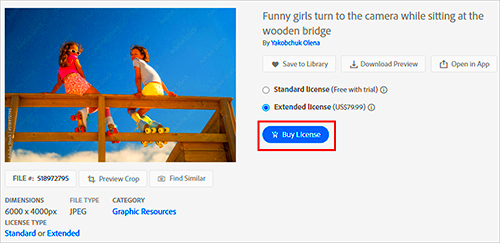At the outset, I was filled with enthusiasm and bewilderment at the multiplicity of licensing options when I entered into stock photography.
Adobe Stock provides numerous licenses which serve different requirements, however what does this mean to you as a user? In layman’s terms, licensing is akin to a permission slip that permits image usage for certain reasons. Understanding this can help avoid future troubles.The two main categories of licenses that
Adobe Stock has are Standard and Extended. Each has its own set of usage, distribution and modification rules. With a Standard license, you may utilize the images on the web, in print and social media platforms but there are restrictions on items such as merchandises. On the other hand, an Extended license permits greater utilization which becomes vital for companies searching for increasing their business volume.
Adobe Stock offers a range of licenses, but the two main categories are Standard and Extended. Each one comes with its own set of rules relating to usage, distribution and modification. For example, when it comes to the Standard license you can use images on webpages, in print outs or via social media networks but there are restrictions in terms of selling goods made out of those images. Oppositely speaking an Extended license allows for greater liberties that are necessary for companies seeking to increase their business output.
Checking Your Unlicensed Photos
Are you ever in a situation when you countenance a flood of pictures and wish to know which of them are unlicensed? The first time I made an effort to comb through my collection it felt like hunting for something that could never be found. In any case, it is easier than it seems to check your unlicensed images, and this serves to keep your part clean and up to date.
To check your unlicensed photos on Adobe Stock, follow these easy steps:- Log In: First, log into your Adobe Stock account.
- Go to Your Downloads: Navigate to the "My Downloads" section where all your images are stored.
- Filter Your Images: Use the filter options to sort by licensing status. This will quickly show you which images are licensed and which are unlicensed.
- Review Regularly: Make it a habit to check your unlicensed images every few months. This not only helps with compliance but also keeps your creative space clutter-free.
By keeping it consistent, I’ve eliminated several future migraines. Long ago, I misplaced an image that was illegal to use in a presentation by mistake. The shame was real! As such, inspecting your unlicensed pictures periodically is not simply good practice; it brings tranquility to the soul.
Impact of Unlicensing on Your Account
Unlicensing of images may seem huge but understanding how it impacts on your account can ease the burden. Say you had downloaded several pictures for some project only to find out later that there were ones you need not anymore; what happens next? This is where consequences of de-licensing come into focus.
The following points should be taken into account when you remove the licensing from a photograph:- Storage Space: Unlicensing frees up your storage quota, allowing you to add new images without worrying about limits.
- Financial Considerations: Depending on your subscription plan, unlicensing can affect your credit balance. Make sure to understand how it works.
- Reputation: Maintaining licensed images reflects professionalism. Unlicensing unnecessary photos enhances your credibility.
In my personal life, there were few unlicensed pictures which were cluttering my account at the time. Once they were cleaned, I don’t remember feeling so good about anything else ever! It’s similar to how one feels when decluttering their house— new doors will open!
Alternatives to Unlicensing
In case deregulatory approaches seem extreme, it’s important to consider other options which can still be suitable for you. Personally, I have experienced moments when I did not want to lose a picture but at the same time paying for an unused license was something out of question. Alternatives include:
- Temporary Archive: Instead of unlicensing, consider archiving images you might use later. This keeps them accessible without cluttering your active projects.
- Updating Usage: If your needs have shifted, check if you can update the usage rights instead of completely unlicensing. This often retains the image for your new direction.
- Sharing with Team Members: If you're part of a team, see if others can make use of the images. This way, you're still utilizing your resources effectively.
As I went through my journey, I realised that it is not always about releasing things. It is sometimes about adapting. There was one time when I had held an image which did not fit into my current project, but later used it in a different context and became popular! So before un-licensing think freely on how else you can use your images.
Best Practices for Using Stock Photos
The use of stock images can significantly certainly improve your projects; yet, it is something I have come to understand through experience. At my start, I would blindly collect any photo that caught my attention irrespective of their connection to what I was doing. However, eventually I learnt some good methods which changed everything in what I was doing.
In this regard, below are a few suggestions that may prove useful for you:- Choose Images that Resonate: Select photos that connect emotionally with your audience. For instance, a warm family moment can evoke feelings of nostalgia, enhancing your message.
- Maintain Consistency: Stick to a particular style or color palette. This creates a cohesive look across your project. I once revamped a presentation that initially looked disjointed, and the change was remarkable.
- Always Credit the Source: Even if it’s not required, crediting the photographer shows respect for their work. I make it a point to include this whenever possible—it’s a simple way to honor the creator.
- Modify Where Needed: Feel free to edit images to better suit your needs. Whether it’s cropping or adjusting colors, making images your own can help them feel more personalized.
At the end of the day, employing stock images judiciously has the potential to improve your narrative and branding. I have seen that an ordinary assignment can turn out extraordinary with appropriate pictures embedded.Chose them wisely!
FAQ
While roaming through the arena of stock photography, I often wondered the same things as many did. Below are some frequently asked questions that should help others like they helped me:
Can I use stock photos for commercial purposes?
- Yes, but make sure to check the license type to ensure it covers your intended use.
What should I do if I find an image I love but can’t afford it?
- Look for free alternatives or consider contacting the creator for a possible deal.
Are there limits on how many times I can use a stock photo?
- Generally, as long as you have the appropriate license, there are no limits on usage, but check the specific terms.
What happens if I unlicense a photo?
- Unlicensing removes your rights to use that image, so ensure you truly don’t need it before proceeding.
I think these inquiries could help you begin your journey in gaining clarity. Please don’t hesitate to ask; help is always available from the society.
Conclusion
Thinking back on my experience with stock photography, it is apparent how much I’ve learnt and matured through it all. My experiences with licensing as well as the practice of unlicensing have been instrumental in forming my perspective along this journey. It is my sincere hope that this guide will be of much help to you as you try to find your way around.At all means, don’t treat stock images as mere items of beauty they are. These pictures can tell stories and evoke feelings that appeal to your target audience. Just like in any good talk, the most touching image has the power of changing an ordinary situation into one that remains stuck forever within one’s mind.Thus, do not forget these practices as you make progress and allow your creativity to remain unleashed. Here’s wishing you success in catching and disseminating marvelous narratives via stock photography’s enchantment!

 admin
admin








